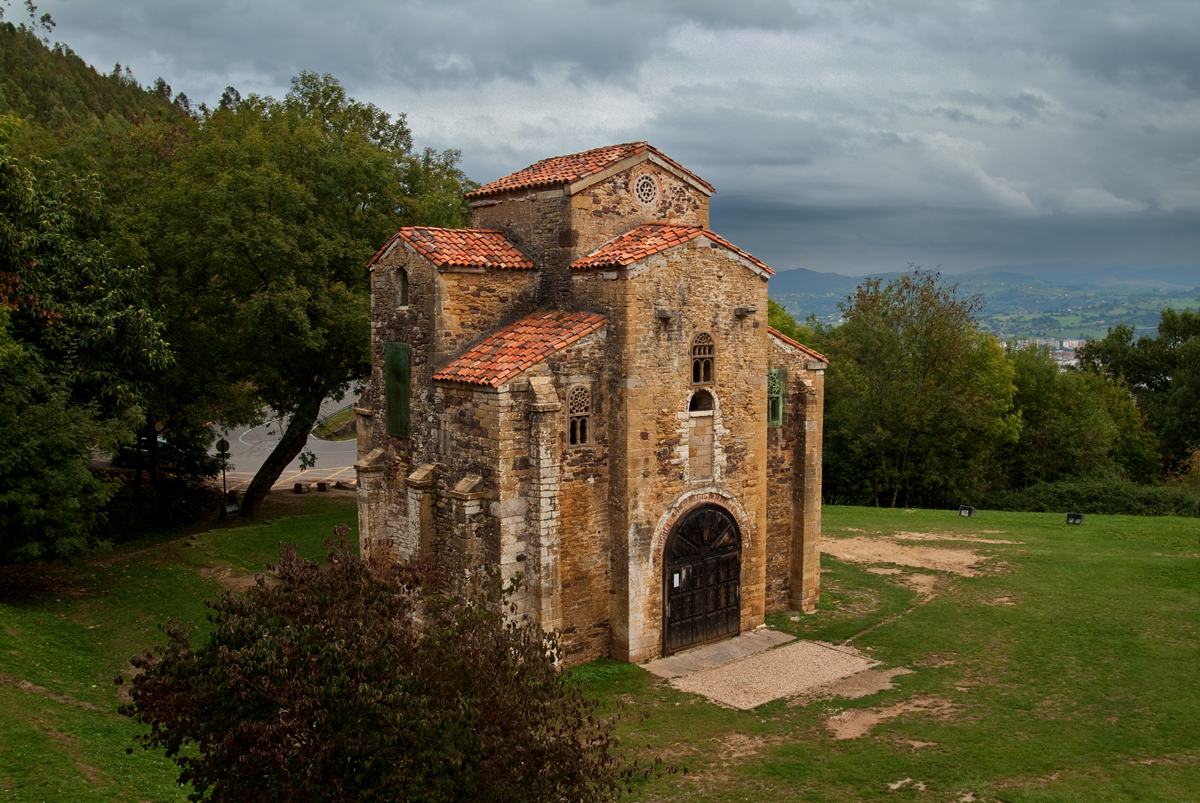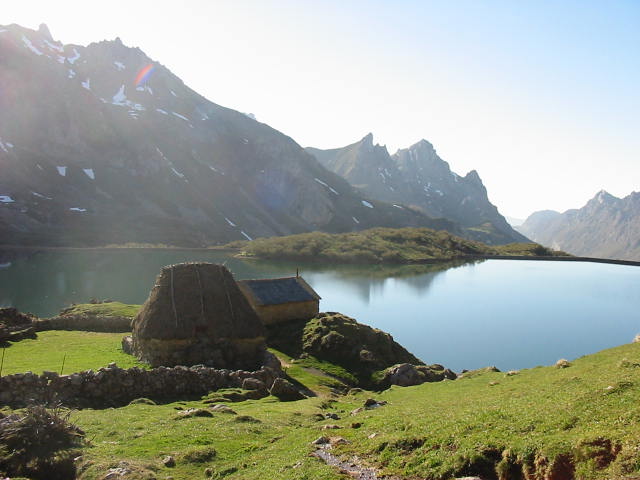|
Oviedo
Oviedo () or Uviéu (Asturian language, Asturian: ) is the capital city of the Principality of Asturias in northern Spain and the administrative and commercial centre of the region. It is also the name of the municipality that contains the city. Oviedo is located approximately southwest of Gijón and southeast of Avilés, both of which lie on the shoreline of the Bay of Biscay. Oviedo's proximity to the ocean of less than in combination with its elevated position with areas of the city more than 300 metres above sea level causes the city to have a maritime climate, in spite of its not being located on the shoreline itself. History The Kingdom of Asturias began in 720, with the Visigothic aristocrat Pelagius of Asturias, Pelagius's (685–737) revolt against the Muslims who at the time were occupying most of the Iberian Peninsula. The Umayyad conquest of Hispania, Moorish invasion that began in 711 had taken control of most of the peninsula, until the revolt in the nort ... [...More Info...] [...Related Items...] OR: [Wikipedia] [Google] [Baidu] |
Cathedral Of Oviedo
The Metropolitan Cathedral Basilica of the Holy Saviour or Cathedral of San Salvador (, ) is a Roman Catholic church and minor basilica in the centre of Oviedo, in the Asturias region of northern Spain. The Cathedral of San Salvador of Oviedo today displays an array of architectural styles, from Pre-Romanesque to Baroque, including Romanesque, Gothic and Renaissance parts. History The church began as a large Pre-Romanesque basilica in the present location of the Gothic cathedral, but nothing more is known about that first building, built by order of King Alfonso II of Asturias. The cathedral was founded by King Fruela I of Asturias in 781 AD, and enlarged in 802 by his son Alfonso II of Asturias known as ''Alfonso the Chaste'', who made Oviedo the capital of Kingdom of Asturias, and resided in Oviedo with his court. He created the See of Oviedo in 810. The present edifice was begun by Bishop Gutierre of Toledo in 1388, and the tower added by Cardinal Francisco Mendoza de ... [...More Info...] [...Related Items...] OR: [Wikipedia] [Google] [Baidu] |
Asturias
Asturias (; ; ) officially the Principality of Asturias, is an autonomous communities of Spain, autonomous community in northwest Spain. It is coextensive with the provinces of Spain, province of Asturias and contains some of the territory that was part of the larger Kingdom of Asturias in the Middle Ages. Divided into eight Comarcas of Asturias, ''comarcas'' (counties), the autonomous community of Asturias is bordered by Cantabria to the east, by Province of León, León (Castile and León) to the south, by Province of Lugo, Lugo (Galicia (Spain), Galicia) to the west, and by the Cantabrian Sea to the north. Asturias is situated in a mountainous setting with vast greenery and lush vegetation, making it part of Green Spain. The region has a oceanic climate, maritime climate. It receives plenty of annual rainfall and little sunshine by Spanish standards and has very moderate seasons, most often averaging in the lower 20s Celsius. Heat waves are rare due to mountains blocking s ... [...More Info...] [...Related Items...] OR: [Wikipedia] [Google] [Baidu] |
Santa María Del Naranco
The church of Saint Mary at Mount Naranco (; ) is a pre-Romanesque Asturian building on the slope of Mount Naranco situated from Oviedo, northern Spain. Ramiro I of Asturias ordered it to be built as a royal palace, part of a larger complex that also incorporated the nearby church of San Miguel de Lillo, 100 meters away. The palace was completed in 842 and had in part a religious function, being consecrated in 848. Its structural features, such as the barrel vault—with transverse ribs corresponding one-to-one with contraforts at the exterior, make it a clear precursor of the Romanesque construction. The exterior decorations, as well as the use of stilted arches, mark the intended verticality of the composition. It was declared a '' Monumento Nacional'' on 24 January 1885. Along with all other national monuments of Spain, it was classified as a ''Bien de Interés Cultural'' in June 1985. It was declared a World Heritage Site by UNESCO in December 1985. History Buil ... [...More Info...] [...Related Items...] OR: [Wikipedia] [Google] [Baidu] |
Gijón
Gijón () or () is a city and municipality in north-western Spain. It is the largest city and Municipalities of Spain, municipality by population in the autonomous communities of Spain, autonomous community of Asturias. It is located on the coast of the Cantabrian Sea in the Bay of Biscay, in the central-northern part of Asturias; it is approximately north-east of Oviedo, the capital of Asturias, and from Avilés. With a population of 273,744 as of 2023, Gijón is the Ranked lists of Spanish municipalities, 15th largest city in Spain. Gijón forms part of a large metropolitan area that includes twenty councils in the center of the region, structured with a dense network of roads, highways and railways and with a population of 835,053 inhabitants in 2011, making it the seventh largest in Spain. During the 20th century, Gijón developed as an industrial city in the steel and naval industries. However, due to the decline in manufacturing in these industries, in recent years Gij� ... [...More Info...] [...Related Items...] OR: [Wikipedia] [Google] [Baidu] |
Asturian Language
Asturian (; )Art. 1 de lLey 1/1998, de 23 de marzo, de uso y promoción del bable/asturiano [Law 1/93, of March 23, on the Use and Promotion of the Asturian Language/nowiki>] is a West Iberian languages, West Iberian Romance languages, Romance language spoken in the Principality of Asturias, Spain. Asturian is part of a wider linguistic group, the Asturleonese languages. The number of speakers is estimated at 100,000 (native) and 450,000 (second language). The dialects of the Astur-Leonese language family are traditionally classified in three groups: Western, Central, and Eastern. For historical and demographic reasons, the Standard language, standard is based on #Dialects, Central Asturian. Asturian has a distinct grammar, dictionary, and orthography. It is regulated by the Academy of the Asturian Language. Although it is not an official language of Spain, it is protected under the Statute of Autonomy of Asturias and is an elective language in schools. For much of its history ... [...More Info...] [...Related Items...] OR: [Wikipedia] [Google] [Baidu] |
Kingdom Of Asturias
The Kingdom of Asturias was a kingdom in the Iberian Peninsula founded by the nobleman Pelagius who traditionally has been described as being of Visigothic stock. Modern research is leaning towards the view that Pelagius was of Hispano-Roman origins. The Kingdom of Asturias was the first Christian political entity to be established in the Iberian Peninsula after the Umayyad conquest of Visigothic Hispania in 711-718. In the Summer of 722,Amy G. Remensnyder, ''La Conquistadora: The Virgin Mary at War and Peace in the Old and New Worlds'', (Oxford University Press, 2014), 23. Pelagius defeated an Umayyad army at the Battle of Covadonga, in what is retroactively regarded as the beginning of the Christian ''Reconquista''. The Asturian kings would occasionally make peace with the Muslims, particularly at times when they needed to pursue their other enemies, mainly rebel Basques and Galicians. Thus Fruela I (757–768) fought Muslims but also defeated the Basques and Galicians, ... [...More Info...] [...Related Items...] OR: [Wikipedia] [Google] [Baidu] |
Oviedo (Asturian Comarca)
Oviedo is one of 8 '' comarcas'' of the province and autonomous community of Asturias in Spain. The comarca is formed by 21 municipalities (''municipios''). From east to west they are: * Cabranes * Nava * Sariegu * Bimenes * Siero * Noreña *Oviedo * Llanera * Les Regueres * Ribera de Arriba * Morcín * Riosa * Santu Adrianu *Grau *Quirós Quirós is a municipality in the Autonomous Community of the Principality of Asturias, Spain. To the southeast is the municipality of Lena, to the south lies the Autonomous Community of León, to the northeast Riosa and Morcín, to the north ... * Teberga * Proaza * Yernes y Tameza * Somiedu * Salas * Miranda Comarcas of Asturias {{Asturias-geo-stub ... [...More Info...] [...Related Items...] OR: [Wikipedia] [Google] [Baidu] |
Provinces Of Spain
A province in Spain * , ; grammatical number, sing. ''provincia'') * Basque language, Basque (, grammatical number, sing. ''probintzia''. * Catalan language, Catalan (), grammatical number, sing. ''província''. * Galician language, Galician (), grammatical number, sing. ''provincia''. is a political divisions of Spain, territorial division defined as a collection of municipalities of Spain, municipalities. The current provinces of Spain correspond by and large to the provinces created under the purview of the 1833 territorial division of Spain, 1833 territorial re-organization of Spain, with a similar predecessor from 1822 territorial division of Spain, 1822 (during the Trienio Liberal) and an earlier precedent in the 1810 Napoleonic division of Spain into 84 prefectures. There are many other groupings of municipalities that comprise the local government in Spain, local government of Spain. The boundaries of provinces can only be altered by the Spanish Parliament, giving ri ... [...More Info...] [...Related Items...] OR: [Wikipedia] [Google] [Baidu] |
Pelagius Of Asturias
Pelagius (; – 737) was a nobleman who founded the Kingdom of Asturias in 718.; ; ; Pelagius is credited with initiating the ''Reconquista'', the Christian reconquest of the Iberian Peninsula from the Moors, and establishing the Asturian monarchy, making him the forefather of all the future Iberian monarchies, including the Kings of Castile, the Kings of León, and the Kings of Portugal. Early life Pelagius was born around 685, although the exact details of his early life remain largely unknown. Traditionally, Pelagius was depicted as of Visigothic origin. Recent scholarship increasingly supports that Pelagius was a nobleman of Hispano-Roman descent, linked to the local Asturian elite. Historical texts emphasize Pelayo's connection to the local Asturian society. He is believed to be the son of Favila. The '' Chronica Albeldense'', elaborated three centuries after his death, says that Favila was a ''dux'' of Gallaecia, who was killed by Wittiza. The ''Chronicle of Alfonso II ... [...More Info...] [...Related Items...] OR: [Wikipedia] [Google] [Baidu] |
General Junta Of The Principality Of Asturias
The General Junta of the Principality of Asturias (in Spanish language, Spanish: ''Junta General del Principado de Asturias'', in Asturian Language, Asturian: ''Xunta Xeneral del Principáu d'Asturies'') is the parliament of Asturias, an autonomous community of Spain, autonomous community of Spain. Its Statute of Autonomy of Asturias, Statute of Autonomy, the basic Spanish Organic Law, organic law of the community, defines it as the supreme institution of representation of the Asturian people. Established in its current form in 1982, the General Junta is named after an Asturian political institution that existed from the Middle Ages to the 19th century. The General Junta exercises legislative power, approves the budgets of the community, and holds to account the Council of Government, the executive power, executive branch, whose leader it elects as the "President of the Principality of Asturias". It also exercises all competences conferred or devolved to the autonomous communities ... [...More Info...] [...Related Items...] OR: [Wikipedia] [Google] [Baidu] |
Autonomous Communities Of Spain
The autonomous communities () are the first-level political divisions of Spain, administrative divisions of Spain, created in accordance with the Constitution of Spain, Spanish Constitution of 1978, with the aim of guaranteeing limited autonomy to the nationalities and regions of Spain, nationalities and regions that make up Spain. There are 17 autonomous communities and two autonomous cities (Ceuta and Melilla) that are collectively known as "autonomies". The two autonomous cities have the right to become autonomous communities. The autonomous communities exercise their right to self-government within the limits set forth in the constitution and Organic Law (Spain), organic laws known as Statute of Autonomy, Statutes of Autonomy, which broadly define the powers that they assume. Each statute sets out the devolved powers () for each community; typically those communities with stronger local nationalism have more powers, and this type of devolution has been called ''asymmetric ... [...More Info...] [...Related Items...] OR: [Wikipedia] [Google] [Baidu] |





